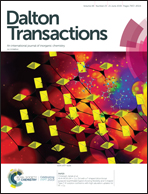Holmium, thulium and lutetium-octamolybdate [Mo8O28]8− 1D chains: luminescence investigation of europium doped lutetium-octamolybdate†
Abstract
In this work we report a novel lanthanide octamolybdate 1D chain type of structure formed with holmium, thulium and lutetium. This is a rare case of compounds built out of [Mo8O28]8− units. These compounds were prepared in a mild reaction synthesis starting from the commonly used heptamolybdate polyoxometalate (POM) [(NH4)6[Mo7O24]. Interestingly, in our previous study we have employed a very similar synthesis route for lanthanides with a larger ionic radius and obtained heptamolybdate clusters. For the lanthanides with a smaller ionic radius (Ho3+, Tm3+ and Lu3+) no crystals could be obtained under those conditions. Only when doubling the amount of the lanthanide salt, single crystals suitable for measurements were obtained. These crystals revealed yet a very different structure from those previously observed. Lanthanide octamolybdate 1D chains were formed. Doubling the amount of the salt for other lanthanide ions still yielded heptamolybdate compounds previously reported by us. The lutetium octamolybdate compound was doped with 1–7.5% of Eu3+ ions yielding emission colors ranging from blue to strong red. Additionally in these materials the excitation wavelength was varied, and it was observed that the materials emission color was excitation-wavelength dependent.
![Graphical abstract: Holmium, thulium and lutetium-octamolybdate [Mo8O28]8− 1D chains: luminescence investigation of europium doped lutetium-octamolybdate](/en/Image/Get?imageInfo.ImageType=GA&imageInfo.ImageIdentifier.ManuscriptID=C9DT00695H&imageInfo.ImageIdentifier.Year=2019)


 Please wait while we load your content...
Please wait while we load your content...